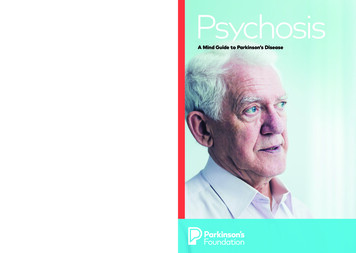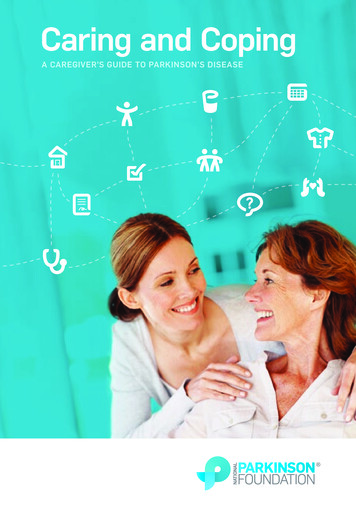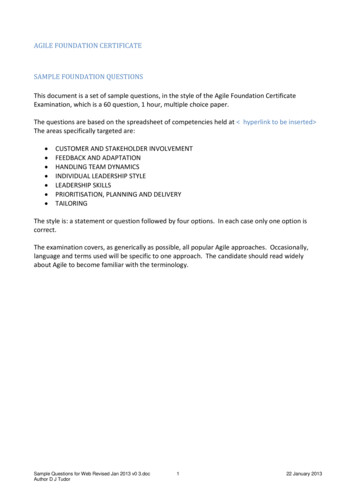
Transcription
MoodA Mind Guide to Parkinson’s Disease200 SE 1st Street, Suite 800Miami, Florida 331311359 Broadway, Suite 1509New York, New York 10018helpline:800. 4PD.INFO (473.4636)helpline@parkinson.orgparkinson. org
About the Parkinson’s FoundationThe Parkinson’s Foundation makes life better for people with Parkinson’sdisease by improving care and advancing research toward a cure.In everything we do, we build on the energy, experience and passionof our global Parkinson’s community. A wealth of information aboutParkinson’s and about our activities and resources is available on ourwebsite, Parkinson.org.Your feedback matters!We’d like to know what you think of our publications and programs.Please take a few moments to fill out our online feedback form.Your answers will be used to improve our resources and will benefitpeople with Parkinson’s, caregivers, families and others in theParkinson’s community. Thank you for your help.Online form:About this bookGlossaryDefinitions for all words underlined in blue canbe found in the glossary starting on page 54.A comprehensive Parkinson’s disease glossarycan be found at Parkinson.org/glossary.IndexAn index of key words and topics can be foundon page 59.parkinson’s foundation resourcesCertain pages include tip sheets with practicalpointers. You can find more helpful tips formanaging Parkinson’s in the books, fact sheets,videos and podcasts in our PD library atParkinson.org/library. In particular, watch“Depression and PD: Treatment Options”from our Expert Briefings webinar series.Parkinson.org/feedbackYour generosity makes this publication possible.The Parkinson’s Foundation is proud to provide this booklet and othereducational materials at no cost to people around the globe. If you foundthis book helpful, please consider a gift so that we may continue to fightParkinson’s on all fronts: funding innovative research, providing supportservices and offering educational materials such as this publication.Thank you for your support.Donate online:Parkinson.org/donateDonate by mail: Parkinson’s Foundation200 SE 1st St, Suite 800Miami, FL 33131Donate by phone:1-800-4PD-INFO (473-4636)Tax ID:13-1866796The information contained in this publication is provided for informational and educationalpurposes only and should not be construed to be a diagnosis, treatment, regimen or anyother healthcare advice or instruction. The reader should seek his or her own medical orother professional advice, which this publication is not intended to replace or supplement.The Parkinson’s Foundation disclaims any responsibility and liability of any kind inconnection with the reader,s use of the information contained herein. 2018
1Everyone experiences changes in mood over the course ofany given day, week, month and year. But “mood changes”is a broad term that can mean different things to differentpeople. This guide explains what mood changes can happenin Parkinson’s disease (PD), why people with Parkinson’smight experience these changes and how to treat and copewith them.Not everyone develops every symptom of Parkinson’s disease,but if you’re affected, non-motor symptoms includingdepression, anxiety, anger and irritability can have a hugeimpact on your quality of life and those around you. Theinformation, tips and stories included here will provideanswers, help you organize thoughts and questions for yourmedical team and remind you that you are not alone on thisParkinson’s journey.
2ContentsAboutParkinson’sDisease5What IsMood?7Other MoodIssues42Talking AboutChanges inYour Mood47
3Depression12Anxiety35Summary 53Glossary 54Index 59Tips forCaregivers49
4AcknowledgementsThis book was written and reviewed by:Kate Perepezko, MSPHGregory Pontone, MDJohns Hopkins University School of MedicineLinda Minton, MPHEast End StrategicSome information and examples in Chapters 2 and3 are from talks by Roseanne Dobkin, PhD, RutgersRobert Wood Johnson Medical School, at the 2016World Parkinson Congress and in a 2017 Parkinson’sFoundation Expert Briefing webinar.This book has been made possible throughthe generous donations of thousands ofindividuals affected by Parkinson’s.Design: Ultravirgo
5chapter oneAbout Parkinson’sDiseaseIf you’re reading this book, you are probably alreadyfamiliar with Parkinson’s disease, but here are somebasics: Parkinson’s is a progressive neurological disorderthat affects about one million people in the United Statesand ten million people worldwide. It is called a movementdisorder because of the tremors, slowing and stiffeningmovements it can cause, but its symptoms are diverseand usually develop slowly over time.Parkinson’s disease is not diagnosed with a test or a scan; instead it isdiagnosed by your doctor, who asks you questions about your health andmedical history and observes your movement. Your doctor may want youto have some tests or imaging; some, like an MRI, can help rule out otherconditions, while others, like DaTScan, can help confirm a Parkinson’sdiagnosis if there is uncertainty. The goal of treatment is to help you manageyour symptoms. Good symptom management can help you to stay healthy,exercise and keep yourself in the best possible shape. Although at this timethere is no way to correct the brain changes that cause Parkinson’s, weknow that exercise can help you maintain your ability to fight the diseaseand that staying healthy can reduce setbacks that make PD progress faster.Great care is an important part of living your best life with Parkinson’s.
6moodLack of dopamine in people with Parkinson’s was first described in the 1960s.Dopamine is a type of neurotransmitter, or chemical messenger, one of severalchemicals your brain cells use to send signals to one another. Soon after,dopamine-replacement therapy using levodopa became – and remains – thegold standard treatment. However, we know that the dopamine system is notthe only one affected by Parkinson’s. The disease process also disrupts otherbrain networks, including those linked to mood, behavior and thinking(cognition). You might also hear that Parkinson’s is linked to a protein in thehuman brain called alpha-synuclein. Researchers continue to study how cellsand brain networks are affected in Parkinson’s to improve our understandingof the disease and potential for treatments.You and your family may have questions or fears about Parkinson’s andgenetics. While there are several genetic mutations that can increase your risk,for the vast majority of people, Parkinson’s is not inherited. There is no testthat can accurately predict who will develop Parkinson’s. Extensive gene andbiomarker research is underway to uncover the possible factors involved in –not necessarily causes of – disease development.
7chapter twoWhat Is Mood?Mood refers to a temporary state of mind or generalizedstate of feeling. A mood – be it happy, sad, frustrated, relaxed,cranky, surprised or any other of a long list of possible mentaland emotional states – can last a few minutes or a few weeksand changes based on exposure to different stimuli. Generally,your mood changes in a manner appropriate to the situation.For example, you get promoted at work and are in a goodmood for weeks. Or, you are intensely sad after your dogdies, but the grief lessens over the course of a few months.Mood changes happen to everyone, but in people with PDmood can become disordered, with changes that are extremeand persistent or inappropriate to the social context. Mooddisorders can be greatly improved with medical treatment,so you can keep living your best possible life.
8moodWhat Affects My Mood?The Disease ExperiencePeople with Parkinson’s, along with your caregivers, family and friends,experience a range of emotions over the course of the Parkinson’s journey:shock and denial at diagnosis, or validation that your suspicions wereconfirmed; fear of the loss of control; frustration or shame as symptomsworsen; satisfaction as medications improve symptoms or from caring fora loved one; concern about the future and what to expect; exasperation,relief, anger, grief, joy. As the disease progresses, you will have to come toterms with it again and again.BiologyWhile it is understandable, and normal, to feel sad upon receiving a diagnosisof Parkinson’s, for many people the sadness is more serious, and it is not justa reaction to learning you have a progressive disease. Parkinson’s is also calleda neuropsychiatric disease. This means it is a disease of the nervous system(“neuro”) that may involve changes in mental health (“psychiatric”).Emotional and behavioral changes are common in people with chronicdiseases, but these changes are even more common in PD. The sameneurotransmitters (e.g., dopamine) that regulate movement also regulateour mood. Therefore, the same processes in the brain that lead to the moreclassical symptoms of Parkinson’s disease can cause depression. Whendopamine-producing cells in the brain die, movement AND mood can beaffected. In this case, depression is actually a symptom of PD, not a reactionto the diagnosis. In fact, depression and other mental health symptoms oftenappear before the onset of motor symptoms. Only looking back after a PDdiagnosis do people realize the connection. There are even studies that suggestpeople with depression and anxiety are more likely to go on to develop PD.While clinical evaluation for depression and anxiety is a must, blood workshould also be done to rule out common disorders that can mimic depression.For example, thyroid disease, anemia, hyponatremia, B12 deficiency, syphilisand other conditions may look like a depressive disorder but require medicalintervention, not including antidepressants, to treat.
What is Mood?9Depression and anxiety can occur at any stage of PD – even before yourParkinson’s diagnosis. These graphs show the relationship between PDdiagnosis and first episode of depression (top) and anxiety (bottom). As youcan see (lines in gray), many people experience depression and anxiety yearsbefore Parkinson’s motor symptoms. Lines in blue show people who firstnoticed depression or anxiety after their PD diagnosis.Duration Between Earliest Depression Episode and PD DiagnosisFREQUENCY1412PARKINSON’S Ishihara and Brayne 2006Duration Between Earliest Anxiety Episode and PD DiagnosisFREQUENCY1412PARKINSON’S DIAGNOSIS108642-60-50-40-30-20-10YEARS
10 moodMedicationDepression, anxiety, anger and other mood changes can be side effectsof medication. For example, in rare cases, dopamine agonist drugs likepramipexole and ropinirole have been associated with mood and behaviorchanges, specifically impulsive behaviors. Interactions between yourParkinson’s medications and other drugs can also affect your mood.It is always important to tell your doctors about all the medicationsand supplements you are taking. This may help to reduce the impactof drug interactions.External FactorsSocial, economic and other factors in our everyday environment affectour mood. This includes big things like work, family, financial issues, livingcircumstances and – of course – health, as well as small things, like trafficor the weather. Stress is also a major trigger for emotional changes.TIPThe Parkinson’s Foundation’s Parkinson’s Outcomes Project, the largest-everclinical study of Parkinson’s disease, found that taken together, depressionand anxiety have the greatest impact on the health of people with PD, evenmore than the movement challenges. It is estimated that at least 50%of people will experience some form of depression during their illness, andat least 30% will experience an anxiety disorder. Good news: studies haveshown that treating depression is one of the most significant ways todecrease disability and improve quality of life.
What is Mood? 11How Do I Know if Parkinson’sIs Affecting My Mood?In addition to depression and anxiety, other symptoms of Parkinson’s –such as fatigue and apathy – can affect your mood, as well as otherpeople’s perception of your mood. And, as we know, mood can be definedin different ways reflecting positive or negative changes that are minor ormajor. Sometimes it’s hard to recognize these changes happening in yourself,especially if you’re not familiar with the symptoms. For example, someexperts think that depression in PD often involves frequent, episodic changesin mood versus a constant state of sadness on a daily basis. It’s not justgetting “the blues.”The good news is that mood changes can be treated. So it is important to tellyour doctor about any changes you notice. It can also help to ask your carepartner, family or friends if they have noticed any changes. If you experienceincreasing sadness, hopelessness or anger/irritability; if you notice that youare losing interest in activities you once loved; or if someone mentions thatthey see changes in your mood, it is time to seek help. These may be signsof a mood disorder.The question is not whether the glass is half full or half empty.The question is, can you refill it?
12chapter threeDepressionDepression is a treatable disorder in which overwhelmingfeelings of sadness, loss and hopelessness interfere with yourability to function. If you feel depressed, whether occasionallyor often, you are not alone. Approximately half of all peoplewith PD will experience some form of depression.There are many causes of depression including psychological,biological and social factors. In people with Parkinson’s, animbalance of certain neurotransmitters (brain chemicals thatregulate mood) plays a major role. As with motor symptomsof PD, symptoms of depression can be improved withmedications and other therapies (see page 17). Unlike motorsymptoms, depression can often be treated to full remission.
13Symptoms of DepressionMost people diagnosed with a serious illness will feel grief or hopelessness atsome point, but clinical depression is a distinct medical condition. Each personwho develops depression will experience it differently. There is a common listof reported symptoms, but not everyone will develop them all. The symptomsmight appear in different orders or come and go, and some people will havemore severe symptoms than others. Also, certain characteristic symptomsare similar and may overlap with symptoms of PD.So how do you know when what you are feeling goes beyond normal sadnessand frustration and becomes a depressive disorder? If you have any of thesymptoms below, discuss them with your healthcare team and requesta screening for depression. (See the “Diagnosis” section on page 14.) Feeling slower or restless Decreased interest or pleasure in daily activities Poor attention and difficulty concentrating Decreased energy or fatigue Changes in appetite Changes in sleep (insomnia or oversleeping) Feelings of guilt, blame or worthlessness Thoughts of death or suicideIn addition, persistent physical symptoms that do not respond to treatment,such as headaches, digestive disorders and pain for which no other cause canbe diagnosed, can also be signs of depression.How Is Parkinson’s Depression Different from Regular Depression?The symptoms of depression in Parkinson’s are similar to depression in thegeneral population (review the symptoms above) and can be diagnosed usingthe same criteria. However, PD depression is more commonly accompaniedby anxiety and apathy than depression in the general population. Therefore,in people with Parkinson’s, evidence suggests that anxiety should be includedas a potential symptom for diagnosis. Additionally, depression in PD can morefrequently involve dissatisfaction with life, irritability, sadness, pessimism andsuicidal thoughts (but not actions).
14 moodMood may also change during ”on-off” fluctuations. A general state of uneaseor dissatisfaction with life (dysphoria), irritability and anxiety are the mostcommon mood changes in the “off” state (when medications are not aseffective). If you notice a relationship between mood changes and the timingof your PD medication, tell your neurologist. He or she might adjust yourlevodopa-replacement medications or dosing to reduce “off” time, which,in turn, may help your mood.MORE FREQUENT IN PDLESS FREQUENT IN PDAnxiety DelusionsDysphoria Feelings of failureIrritability Feelings of guiltPessimism Feelings of punishmentSadness HallucinationsSuicidal thoughts Self-blameSuicidal actsDiagnosisDepression is usually diagnosed by your primary care provider or neurologist.Discuss changes in your mood or interests with your healthcare team wheneveryou or caregivers notice differences. Similar to a Parkinson’s diagnosis, thereis no blood test or scan for depression. Rather, diagnosis is based on thesymptoms and changes reported by you or a family member. Screening fordepression can be done in a number of ways: it can be as simple as completingself-report questionnaires or as elaborate as a full neuropsychiatric evaluationwith a battery of tests. Most commonly, depression screening consists ofan in-person interview with your doctor, who asks a series of questions aboutyour mood and daily function to make the diagnosis. It is important to answerthese questions honestly.Depression often goes unrecognized and undiagnosed, in general and in peoplewith Parkinson’s in particular. Changes in voice volume (hypophonia) and facialmuscles (hypomimia, or facial masking) can make it hard for other people tointerpret the mood and expressions of someone with PD. The contrary canalso be true. If facial masking is an issue, people might assume you’re upsetor depressed all the time. This can lead to feelings of anger and frustrationbecause people constantly ask, “What’s wrong?” when you are feeling fine.If this begins to happen to you more often, try explaining the difficulty withmuscle control and expression to those around you. This may help peopleto better understand how you are feeling.
Depression 15Be aware of the symptoms of depression listed on page 13, so you knowwhat to report and how to describe what’s going on. Depression can be mild,moderate or severe based on the symptoms you have and how long you havethem. Clinical depression is classified as either major depressive disorder ordysthymia (persistent mild depression).Regardless of when in your Parkinson’s journey you notice the symptoms,early diagnosis and treatment of depression is critical.Symptoms such as hopelessness, thoughts of suicide or delusional beliefsassociated with a depressed mood should be referred directly to a mentalhealth specialist. Untreated, worsening depression can contribute tosignificant decline in overall health and quality of life. On the flip side,successful treatment of depression is one of the most significant waysto decrease disability and improve quality of life.Depression may be undertreated in people with PD because itis often unrecognized or unreported. This is frequently becausepeople don’t notice or acknowledge their own behavior changes,or they are embarrassed to speak about them.Parkinson’s, Depression and PainThe link between chronic pain and depression is well established. Manypeople with Parkinson’s experience pain at some point during the diseaseprogression, from mild physical discomfort (aching, stiffness) to pain so severeit overshadows all other symptoms, and this, of course, can have a big impacton your mood.If you are suffering from pain, tell your neurologist. He or she may be able toadjust your medications and improve your overall symptoms. It is importantto differentiate between pain that can be addressed with PD medicationadjustments, pain from other causes and pain made worse or caused bydepression and anxiety. Sometimes antidepressants (tricyclics and SNRIs –read more on page 25) are prescribed for nerve pain even without a diagnosisof depression, so they can be good choices for treatment of depression withco-occurring pain.
16 moodTip SheetManaging PainThink about the following questions to help you and your doctorfigure out the cause of your pain. W here is the pain located?Does it stay in one place or move throughout the body? What does your pain feel like?Is it continuous, or does it come and go? W hat triggers your pain?Is it greater after certain activities or at particular times of day? I s the pain better when your medications are “on” and worse whenthey are “off”? What relieves your pain? What makes it worse?Self-Management of Pain If pain begins suddenly or an injury occurs, it is considered acute,especially if there is swelling or bruising. Apply cold packs to the areafor 15–20 minutes several times a day for 48–72 hours. Elevate thearea to decrease swelling. I f pain is long-lasting (chronic), regularly apply heat to the area for15–20 minutes. I f muscles feel tense or knotted, try self-massage. Apply pressure to thearea with a tennis ball or massage tool, using body weight against it fordeeper pressure. Scheduling an appointment with a massage therapistmay be helpful. K eep moving, changing positions frequently, and take stretch breaksthroughout the day.If pain lasts more than two weeks, intensifies or worsens or interfereswith daily function or sleep, talk to your doctor as soon as you can.
Depression 17TreatmentFortunately, there are many treatment options for depression, includingtherapies that require a healthcare provider, such as: Psychotherapy Medication Electroconvulsive therapy, or ECT (for severe cases) Experimental therapies as well as things you can do yourself with the guidance of a healthcareprovider: Exercise Social support Nutrition Complementary therapiesTalk to your healthcare team to find the right treatment(s) for you. PDdepression is most effectively treated with a combination of approaches,incorporating talk therapy and medication, in addition to exercise and/orsocial support.Take depression seriously and treat it aggressively.About a year after Phillip was diagnosed with PD, he began havingtrouble sleeping. He woke up several times throughout the night andcouldn’t stop tossing and turning. He felt tired during the day butassumed it was because of his PD. His daughter, Barbara, also noticedthat her dad wasn’t leaving the house as often as he used to and stoppedgoing to his regular Thursday night poker group. Barbara made anappointment with Phillip’s doctor, and they reported his trouble sleeping.After talking with Phillip and Barbara, the doctor realized that Philliphad a few symptoms of depression. The doctor shared that many peoplewith PD suffer from depression that can interfere with sleep and theirdesire to participate in their normal activities. Together, the doctor,Phillip and Barbara worked out a plan to have Phillip try a combinationof melatonin and antidepressants to see if that would help him sleepand begin to feel more like himself again.
18 moodThe importance of mental health therapy is underscored by research fromthe Parkinson’s Outcomes Project. Because it is the largest clinical study ofParkinson’s, with more than 10,000 people with Parkinson’s from around theworld enrolled, we are able to compare the benefits of treatments for specificgroups. For example, we can study people across health centers that havehad Parkinson’s for more than 20 years, people who have frequent falls or –for the purposes of this book – people with severe, long-term (at least twoyears) depression. In this last group, counseling plus medication was 25%more effective at resolving depression than medication alone.So, while medication can be helpful, counseling is necessary to realize thefull benefits of treatment.Counseling plus medication ismore effective atresolving depressionthan medication alone.25%
Depression 19PsychotherapyPsychotherapy is the treatment of a mental or emotional disorder by talking.In general, it offers the opportunity to reflect on your situation and what youare feeling. A therapist can help focus your attention to resolve some of theissues that concern you.Many people are nervous or embarrassed about seeking mental healthcounseling or finding the right therapist. But psychotherapy does not meanyou have to lie on a couch and talk about your childhood. It means findingsomeone who understands your medical condition and the psychologicalcomponent that is part of the disorder. Psychologists, clinical social worker,and licensed mental health professionals have different educational paths butare generally all trained in psychotherapy for treating depression (see page20 for descriptions of these and other healthcare professionals that can beinvolved in treatment of your mood issues).Cultural FactorsHelp-seeking behavior, as well as expression of emotions in general,varies among cultures. For example, there is a belief in some culturesthat depression doesn’t exist, and individuals can “snap” out of it withoutmedical help. Another belief is that people who admit that they aredepressed have a personal weakness or character flaw. Men, especially,are often taught not to display emotion because it isn’t manly. Thus, manypeople do not actively seek out care for this very real medical issue.Similarly, presentation of symptoms can be different depending on yourcultural background. People from many cultures, including Hispanicsand Asians, tend to experience their symptoms of depression as physicalcomplaints rather than mental or emotional symptoms. Within thespecific culture there may be names for patterns of symptoms, suchas “nervios” (the Spanish word for “nerves”) in the Hispanic population.Although it is most like generalized anxiety disorder, the symptomspresented (physical complaints, mood instability and an overall feeling ofbeing out of control) can make diagnosis difficult for doctors not familiarwith the culture.
20 moodWho Can Help Manage Parkinson’s DiseaseMood Changes?If you did not put together your comprehensive care team when you receivedyour Parkinson’s diagnosis, do it now! It makes a big difference for your care tohave a team composed of many of the following healthcare professionals, whoplay different roles in helping manage your PD and associated mood changes.Don’t forget: you and your care partner(s) are also crucial members of thecare team.NEUROLOGISTA neurologist is a doctor who specializes in diagnosing and treating disordersthat affect the brain, spinal cord and nerves (such as Parkinson’s, seizuredisorders and multiple sclerosis). Research from the Parkinson’s OutcomeProject shows that people with Parkinson’s who see a neurologist do betterthan people who see only a primary care provider. Movement disorderspecialists are neurologists who have extra training in Parkinson’s and othermovement disorders, so they have specific knowledge and expertise in treatingthe problems you may face at each stage of the disease.tipTo see if there is a movement disorder specialist near you, call ourHelpline at 1-800-4PD-INFO (473-4636) or visit Parkinson.org/search.PRIMARY CARE PROVIDERA primary care provider (PCP) is a healthcare professional that treatscommon medical problems. This is most often an internist, family practicephysician or geriatrician, but your PCP might be a physician assistant ornurse practitioner. Your PCP manages your overall health, so he or she shouldreceive periodic reports from all of your doctors, including your neurologistand mental health specialist.Nurses can also play a pivotal role in your care. They can suggest educationmaterials, advocate on your behalf and provide care coordination, and theyare often your first line of contact in a doctor’s office.
Depression 21Social workers can help you and your family sort out and resolve issuesassociated with the daily demands of Parkinson’s and life in general(e.g., insurance, housing, disability, familial conflict and more).Licensed clinical social workers and licensed professional counselors bothprovide psychotherapy and many specialize in treating depression, anxietyand relationship issues.Psychologists work with individuals and family members to provide adviceand counseling for coping with PD and other emotional stressors. Many alsoperform specialized testing of mood, cognition and other neuropsychiatricsymptoms that can aid in diagnosis and treatment.Neuropsychologists have additional expertise in how behavior and cognitive(thinking) skills are related to brain structure and symptoms.Health psychologists focus on understanding the biological, psychologicaland sociological relationship between health and illness. They often helpindividuals manage the stress, anxiety and depression that can accompanya chronic illness like Parkinson’s.Psychiatrists are medical doctors who can prescribe medications and whospecialize in the diagnosis and treatment of mental, behavioral or emotionalproblems such as depression and anxiety.Neuropsychiatrists specialize in testing for and treating mental health issuesfor people with disorders of the nervous system, including Parkinson’s.Tip SheetMENTAL HEALTH SPECIALISTSThere are many types of professionals, with different training, that canprovide individual, family and couples counseling, direct you to communityresources or help you build your social support team. It might be difficultto find a psychologist or counselor that specializes in Parkinson’s. However,most mental health professionals treat depression, and many are trained incognitive behavioral therapy (which was shown to be beneficial in a studydone as part of the Parkinson’s Outcomes Project). For help finding counselingin your area, check with your insurance provider or ask your primary careprovider for a referral.
22 moodTypes of PsychotherapyCognitive behavioral therapy (CBT) is a technique that helps people changepatterns of negative thinking and behavior. A cognitive behavioral therapistcan help you recognize patterns of negative thought and speech and teachyou skills to help you cope better and think positively, ultimately reducingsymptoms of depre
brain networks, including those linked to mood, behavior and thinking (cognition). You might also hear that Parkinson’s is linked to a protein in the human brain called alpha-synuclein. Researchers continue to study how cells and brain networks are affected in Parkinson’s to improve our u










